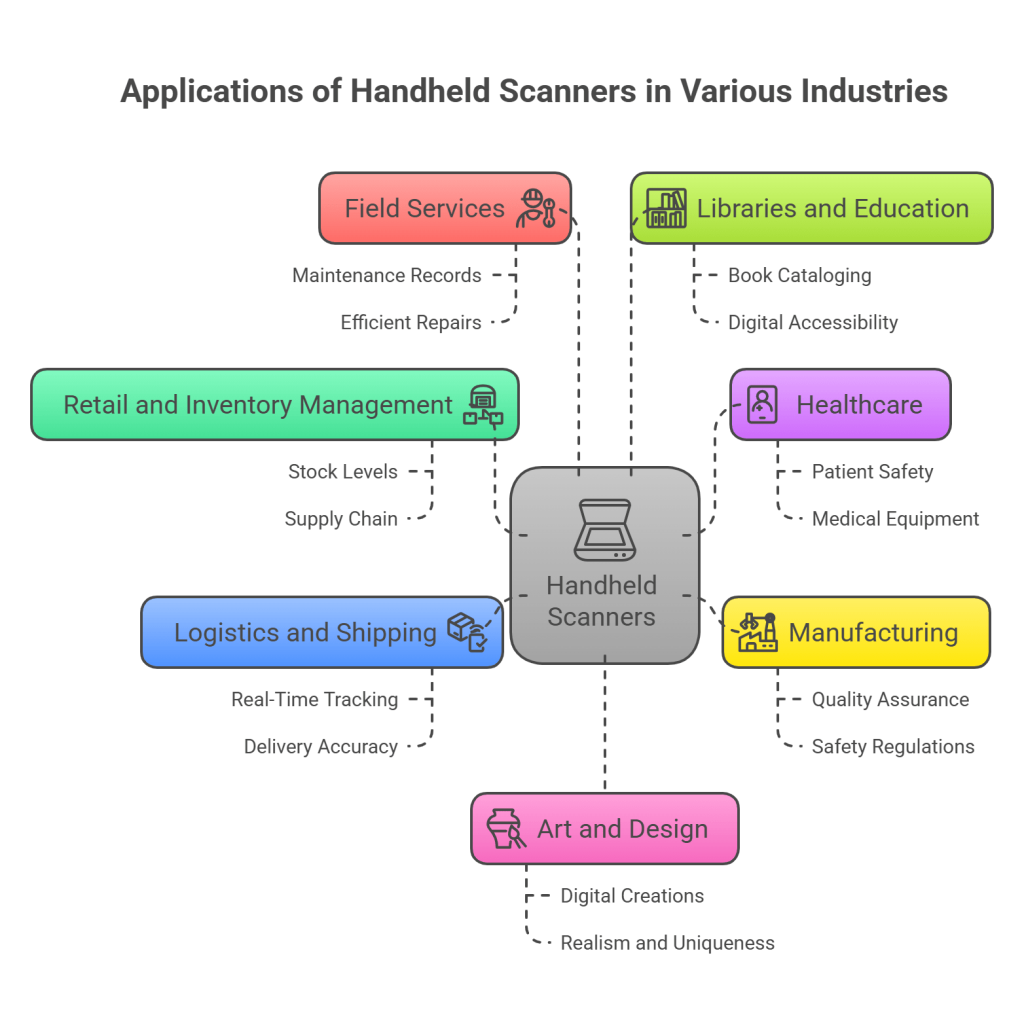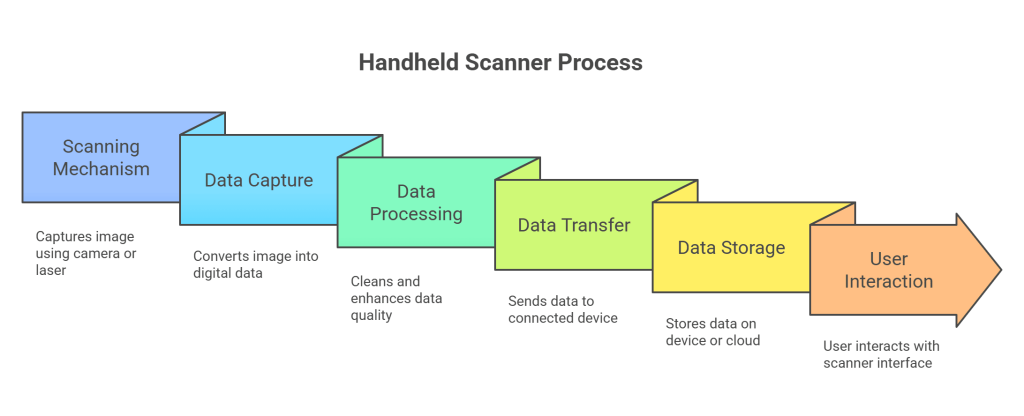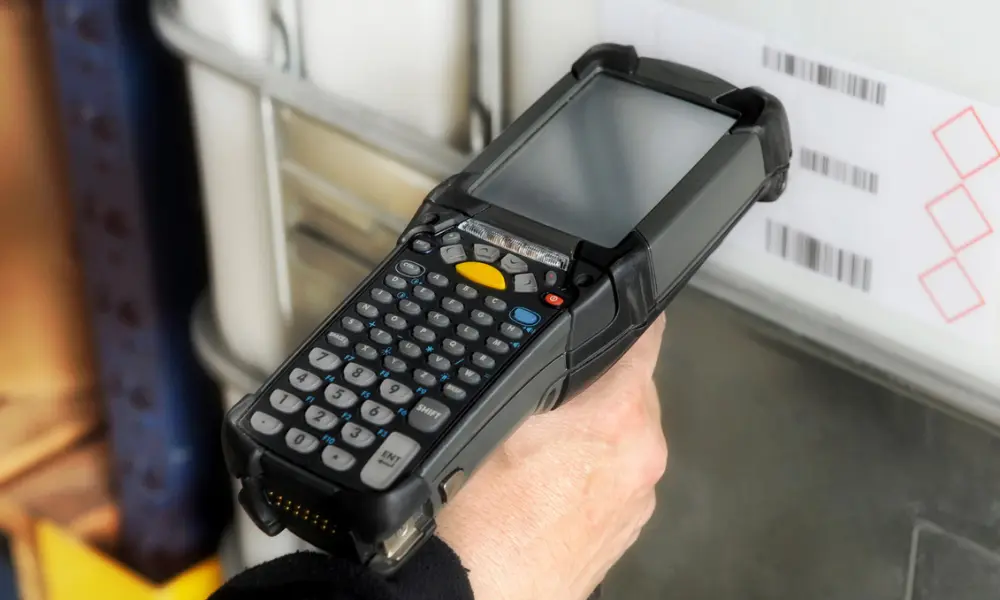Data is the new oil of the 21st century and anything that boosts efficiency in data collection becomes an indispensable tool for the business. Handheld scanners provide the perfect blend of convenience, flexibility, and durability. Whether you are a business professional or a tech-savvy individual, understanding handheld scanner is important for you.
In this blog, we will understand the basic definition of what a handheld scanner is, how the technology works, and the benefits and various applications of scanners.
Let’s begin with the basics and unravel the technology of scanners in this comprehensive guide.

What is a Handheld Scanner?
Understanding the handheld scanner definition is the first step. It is a portable electronic device designed to capture and digitize images or text from physical documents, objects, or surfaces. It allows users to convert physical information into digital format, making it easily accessible, editable, and shareable.
These compact devices are equipped with sensors and optical components that scan and capture data, which can then be stored, processed, or transmitted via a computer or other digital devices.
Applications in Industries

A major part of what is a handheld scanner lies in its applications across various industries thereby enhancing productivity, efficiency, and data management. Let’s explore some of the key sectors where handheld scanners play a crucial role:
1. Retail and Inventory Management
Handheld scanners are invaluable tools for retailers and warehouses. They enable quick and accurate tracking of inventory, allowing businesses to manage stock levels effectively, reduce errors, and streamline the supply chain.
2. Healthcare
In the healthcare sector, handheld scanners are used for patient identification, tracking medical equipment, and scanning barcodes on medications. They help healthcare professionals access critical information swiftly, reducing the risk of errors.
3. Manufacturing
Manufacturers employ handheld scanners for quality control, inspecting products for defects, and monitoring production processes. These devices help ensure products meet industry standards and safety regulations.
4. Logistics and Shipping
In logistics and shipping, handheld scanners facilitate package tracking and management. Couriers and postal services use them to scan barcodes on parcels, ensuring accurate delivery and real-time tracking for customers.
5. Field Services
Field service technicians often carry handheld scanners to read QR codes or barcodes on equipment and machinery. This allows them to access maintenance records and perform repairs efficiently.
6. Libraries and Education
Libraries use handheld scanners to catalog books, making it easier to manage their collections. In education, teachers can quickly digitize teaching materials, making them accessible to students through digital platforms.
7. Art and Design
Artists and designers use handheld scanners to capture textures, patterns, or images from the physical world and incorporate them into digital creations, enhancing their work’s realism and uniqueness.
Benefits of Handheld Scanners
Now that we’ve covered some of the applications let’s explore the benefits of handheld scanners:
1. Portability
One of the primary advantages of handheld scanners is their portability. They are compact and lightweight, allowing users to carry them anywhere, making them ideal for fieldwork and on-the-go tasks.
2. Time Efficiency
Handheld scanners can capture data quickly and accurately, saving valuable time compared to manual data entry. This efficiency is especially critical in industries where speed and precision are paramount.
3. Data Accuracy
By eliminating the potential for human error in data entry, handheld scanners ensure data accuracy. This is particularly vital in fields such as healthcare and manufacturing, where precision is crucial.
4. Ease of Use
Most handheld scanners are user-friendly, requiring minimal training. They feature intuitive interfaces and straightforward operation, making them accessible to a wide range of users.
5. Versatility
Handheld scanners can scan a variety of items, including documents, barcodes, QR codes, and even three-dimensional objects. This versatility makes them suitable for diverse applications.
6. Data Integration
Many handheld scanners can seamlessly integrate with other software and systems, allowing for efficient data transfer and synchronization with databases and inventory management systems.
How Handheld Scanners Work

To understand how handheld scanners work, let’s break down the process step by step:
1. Scanning Mechanism
A handheld scanner consists of a scanning mechanism, which may include a camera or a laser-based system. This mechanism captures an image of the object or document being scanned. Laser scanners typically read 1D barcodes by projecting a laser beam, while imaging scanners capture 2D codes like QR codes through digital imaging. Some modern scanners can handle both.
2. Data Capture
The captured image is converted into digital data. In the case of barcode or QR code scanners, the device reads and deciphers the code, extracting the encoded information. The scanner’s decoder software analyzes the contrast between light and dark areas in the barcode or image to interpret the data embedded in the code.
3. Data Processing
Once the data is captured, it is processed by the scanner’s internal software. This software may clean up the image, correct distortions, or enhance the quality of the data. The processing stage also involves decoding algorithms that confirm the integrity of the scanned information, helping ensure accurate data output to the host system.
4. Data Transfer
The processed data is then transferred to a connected computer or device through wired or wireless connectivity options, such as USB, Bluetooth, or Wi-Fi. Many modern handheld scanners support seamless integration with POS systems, mobile devices, or cloud-based platforms for real-time data sharing and synchronization.
5. Data Storage
The scanned data can be stored on the device or transferred directly to a database or cloud storage, depending on the scanner’s capabilities and user preferences. Internal memory is especially useful for batch scanning, allowing the user to scan multiple items and upload the data all at once later, even without a live connection.
6. User Interaction
Handheld scanners often feature user-friendly interfaces, such as touchscreens or buttons, that allow users to interact with the device and initiate scans. Some advanced scanners include programmable buttons, LED indicators, audible beeps, or haptic feedback to guide users and confirm successful scans.
Best Handheld Scanners Available
Choosing the right handheld scanner for your specific needs can greatly impact your productivity and efficiency. Here are some of the best handheld scanners available in the market:
1. Doxie Go SE – Portable Scanner
- Key Features: Compact, wireless, and rechargeable. Scans documents, photos, and receipts.
- Pros: Portable, excellent image quality, easy to use.
- Cons: Limited to scanning single pages at a time.
2. Epson DS-360W – Wireless Color Document Scanner
- Key Features: Wireless, automatic document feeder, duplex scanning, TWAIN support.
- Pros: High-speed scanning, versatile, supports various document sizes.
- Cons: Relatively large and not as portable as some others.
3. Zebra DS2278 – Handheld Barcode Scanner
- Key Features: Designed for barcode scanning, Bluetooth connectivity, durable.
- Pros: Fast and accurate barcode scanning, suitable for retail and logistics.
- Cons: Specialized for barcode scanning and may not be ideal for other tasks.
4. Fujitsu ScanSnap iX1500 – Desktop Document Scanner
- Key Features: High-speed scanning, wireless, automatic document feeder, versatile.
- Pros: Excellent performance, supports various document types, and easy-to-use software.
- Cons: Relatively larger and not as portable as some handheld scanners.
Advantages of a Handheld Scanner
1. Portability –
Easy to carry and operate anywhere.
2. Time Efficiency –
Speeds up scanning and data entry processes.
3. High Accuracy –
Reduces manual errors in data recording.
4. Real-Time Data Transfer –
Updates inventory or systems instantly.
5. Versatile Use –
Suitable for retail, warehouses, healthcare, manufacturing, and logistics.
6. Cost Savings –
Cuts labor costs by automating data collection.
7. User-Friendly –
Requires minimal training for operation.
Disadvantages of a Handheld Scanner
1. Battery Dependency –
Needs regular charging to function.
2. Limited Range –
Works only within the range of its connectivity (Bluetooth/Wi-Fi).
3. Durability Concerns –
May get damaged if dropped or exposed to harsh conditions.
4. Initial Investment –
Quality scanners can be expensive to purchase.
5. Compatibility Issues –
Some models may not integrate with all software systems.
6. Maintenance Needs –
Requires occasional servicing or calibration
Conclusion
In this complete guide, we’ve explored the fundamental question, “What is a handheld scanner?” and got to know that a handheld scanner is a portable device used to digitize physical information with diverse applications across various industries.
If you are a business professional seeking to streamline your workflows and productivity, get in touch with Qodenext for top-quality scanner integration services.
Now, let’s address some frequently asked questions and try to understand what is handheld scanner.
FAQs – What is a Handheld Scanner
1. What is a handheld scanner used for?
The scanner is used to capture and digitize images, text, or stored data from physical documents, files, and objects. It is usually used in industries like healthcare, manufacturing, and logistics.
2. What is the difference between a handheld scanner and a flatbed scanner?
Handheld scanners are portable and designed for scanning objects or documents by moving the scanner over them. In contrast, flatbed scanners have a stationary glass surface, and the document or object is placed face-down on it for scanning.
3. Can handheld scanners scan color images and documents?
Yes, many handheld scanners are capable of scanning color images and documents. The scanning capabilities may vary depending on the model and brand.
4. Are there any limitations to handheld scanners?
Handheld scanners may have limitations regarding the size of the documents or objects they can scan. Furthermore, there are models that cannot handle high-volume scanning tasks. So, you have to decide on the model depending on your specific needs.
5. How can I choose the right handheld scanner for my needs?
Selecting the right scanner depends on your preference. Consider the features of a model, and compare the pricing between different designs. Next, check the scanning speed, connectivity options, and the types of documents or files that you can scan using the device.
6. How do handheld barcode scanners work?
Laser light is reflected on the label surface and captured by a sensor to read the barcode. The laser beam is used for reading different barcode labels.
7. What is the best handheld scanner?
There are many handheld scanners that offer top-notch services. Big brands like Zebra, Fujitsu, and Hennex are dominating the global scanner market.







